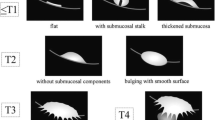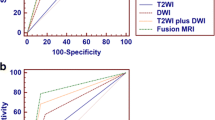Abstract
Purpose
This retrospective study aimed to assess the value of adding diffusion-weighted magnetic resonance imaging (DWI) or gadolinium-enhanced fat-suppressed T1WI (CEI) to T2-weighted imaging (T2WI) for preoperative T categorization in renal pelvic carcinoma by the reader’s experience using surgical specimens as the reference standard.
Methods
Two radiologists (Reader 1; 3 years, 2; 13 years) reviewed 49 cases with urothelial carcinoma who underwent magnetic resonance imaging examination before surgery, independently, using three image sets: T2WI alone, T2WI plus DWI, and T2WI plus CEI for tumor detection and T categorization. The differences in the apparent diffusion coefficient values between tumors and renal parenchyma, histopathologic grade were analyzed.
Results
T2WI plus CEI or DWI had high detection rates (93.4%) compared to T2WI alone. When discriminating T3a/T3b, for Reader 1, the use of T2WI plus DWI (88.0%) and T2WI plus CEI (92.0%) was significantly more accurate than T2WI alone (73%), with AUCs of 0.86, 0.86 and 0.77, respectively. For Reader 2, the accuracies were high on all image sets, with AUCs of 0.87–0.95, and the mean ADC of the tumors was significantly lower than that of the normal renal parenchyma. In addition, the mean ADC values of high-grade tumors were significantly lower than that of low-grade tumors.
Conclusions
DWI and CEI could be more helpful than T2WI alone for preoperative T categorization by less-experienced reader and DWI could be used for preoperative T categorization and for predicting the histopathologic grade of renal pelvic carcinoma.




Similar content being viewed by others
Abbreviations
- DWI:
-
Diffusion-weighted magnetic resonance imaging
- CEI:
-
Gadolinium-enhanced fat-suppressed T1-weighted imaging
- DCEI:
-
Dynamic contrast-enhanced imaging
- T2WI:
-
T2-weighted imaging
- MRI:
-
Magnetic resonance imaging
- ADC:
-
Apparent diffusion coefficient
- DICOM:
-
Digital imaging and communications in medicine
- ROI:
-
Region of interest
- ROC curve:
-
Receiver operating characteristic curve
References
Takeuchi M, Matsuzaki K, Kubo H, et al. (2008) Diffusion-weighted magnetic resonance imaging of urinary epithelial cancer with upper urinary tract obstruction: preliminary results. Acta Radiol 49:1195–1199
Yoshida S, Masuda H, Ishii C, et al. (2008) Initial experience of functional imaging of upper urinary tract neoplasm by diffusion weighted magnetic resonance imaging. Int J Urol 15:140–143
Nishizawa S, Imai S, Okaneya T, et al. (2010) Diffusion weighted imaging in the detection of upper urinary tract urothelial tumors. Int Braz J Urol 36:18–28
Yoshida S, Masuda H, Ishii C, et al. (2011) Usefulness of diffusion-weighted MRI in diagnosis of upper urinary tract cancer. Am J Roentgenol 196:110–116
Cogley JR, Nguyen DD, Ghobrial PM, et al. (2013) Diffusion-weighted MRI of renal cell carcinoma, upper tract urothelial carcinoma, and renal infection: a pictorial review. Jpn J Radiol. 31:643–652
Colin P, Kassouf W, Konety BR, et al. (2015) Diagnosis and evaluation of upper tract urothelial carcinoma (UTUC). upper tract urothelial carcinoma. New York: Springer, pp 31–43
Ye J, Kumar BS, Li Xb, et al. (2015) Clinical applications of diffusion-weighted magnetic resonance imaging in diagnosis of renal lesions–a systematic review. Clin Physiol Funct Imaging. doi: 10.1111/cpf.12313
Akita H, Jinzaki M, Kikuchi E, et al. (2011) Preoperative T categorization and prediction of histopathologic grading of urothelial carcinoma in renal pelvis using diffusion-weighted MRI. Am J Roentgenol 197:1130–1136
Edge SB, Byrd DR, Compton CC, et al. (2015) AJCC cancer staging manual. New York: Springer
Wu CF, Pang ST, Chen CS, et al. (2007) The impact factors on prognosis of patients with pT3 upper urinary tract transitional cell carcinoma. J Urol 178:446–450 (discussion 50)
Langner C, Hutterer G, Chromecki T, et al. (2006) pT classification, grade, and vascular invasion as prognostic indicators in urothelial carcinoma of the upper urinary tract. Mod Pathol 19:272–279
Yoshimura K, Arai Y, Fujimoto H, et al. (2002) Prognostic impact of extensive parenchymal invasion pattern in pT3 renal pelvic transitional cell carcinoma. Cancer 94:3150–3156
Epstein JI, Amin MB, Reuter VR, et al. (1998) The World Health Organization/International Society of Urological Pathology consensus classification of urothelial (transitional cell) neoplasms of the urinary bladder. Am J Surg Pathol 22:1435–1448
Kundel HL, Polansky M (2003) Measurement of observer agreement. Radiology 228:303–308
Wassberg C, Akin O, Vargas HA, et al. (2012) The incremental value of contrast-enhanced MRI in the detection of biopsy-proven local recurrence of prostate cancer after radical prostatectomy: effect of reader experience. AJR Am J Roentgenol 199:360–366
Futterer JJ, Engelbrecht MR, Huisman HJ, et al. (2005) Staging prostate cancer with dynamic contrastenhanced endorectal MR imaging prior to radical prostatectomy: experienced versus less experienced readers. Radiology 237:541–549
Takeuchi M, Suzuki T, Sasaki S, et al. (2012) Clinicopathologic significance of high signal intensity on diffusion-weighted MR imaging in the ureter, urethra, prostate and bone of patients with bladder cancer. Acad Radiol 19:827–833
Uchida Y, Yoshida S, Kobayashi S, et al. (1042) Diffusion-weighted MRI as a potential imaging biomarker reflecting the metastatic potential of upper urinary tract cancer. Br J Radiol 2014(87):20130791
Yoshida S, Koga F, Masuda H, et al. (2014) Role of diffusion weighted magnetic resonance imaging as an imaging biomarker of urothelial carcinoma. Int J Urol 21:1190–1200
Tavora F, Fajardo DA, Lee TK, et al. (2009) Small endoscopic biopsies of the ureter and renal pelvis: pathologic pitfalls. Am J Surg Pathol 33:1540–1546
Author information
Authors and Affiliations
Corresponding author
Ethics declarations
Funding
No funding was received for this study.
Conflict of interest
The authors declare that they have no conflict of interest.
Ethical approval
All procedures performed in the studies involving human participants were in accordance with the ethical standards of the institutional and national research committee and with the 1964 Helsinki declaration and its later amendments or comparable ethical standards. For this type of study, formal consent is not required.
Informed consent
The Institutional Review Board approved the retrospective study protocol and all patients consented to the use of their medical records for research purposes.
Rights and permissions
About this article
Cite this article
Yoshida, R., Yoshizako, T., Maruyama, M. et al. The value of adding diffusion-weighted images for tumor detection and preoperative staging in renal pelvic carcinoma for the reader’s experience. Abdom Radiol 42, 2297–2304 (2017). https://doi.org/10.1007/s00261-017-1116-5
Published:
Issue Date:
DOI: https://doi.org/10.1007/s00261-017-1116-5




